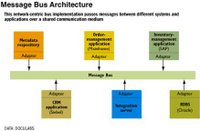Buffer
Popularity of integrations owes largely to the current focus by companies on corporate cost control. So the integration efforts is driven by the need to automate various business process that could be within or outside the enterprise. Just as we need some sort of architecture to build a house, machinery, the same way there comes the need to formulate better architecture to realise their objective for the enterprise as well. Integration Architecture broadly defined as disciplined approach to relate models of complex business processes within/outside the enterprise. Couple of integration architecture have been presented below:Bus Architecture
 1. A de-centralised architecture.
1. A de-centralised architecture.
2. Network BUS acts as a message carrier.
3. Communication pattern is peer-peer.
4. Messages queued up by publisher.
This particular architecture is used in TIBCO.
Hubble-Spoke Architecture
 1. It’s a centralised architecture.
1. It’s a centralised architecture.
2. Hub acts as a server & all messages flow through hub.
3. Communication pattern is Pubslish-Server & Server-Subscriber..
4. Messages queued up in the server.This architecture is used by Webmethods.
Every integration solutions in someway or the other needs to make optimal use of the basic technologies like messaging, routing, translation, transformation, but architecture enables enterprises to implement it strategically & tactically. This helps in minimizing costs by reusing the components as well.
Good architecture will enable the solutions to be plugged in to the infrastructure flexibly. So building an overall architecture is an investment in itself.
Buffer
Aiming for career in Integration Tech.
If you are planning a career shift to Integration Technology, make sure you have these in place. Some handy tips that might make your move smooth.
1. First make sure you have a solid understanding in the tool set. You cannot make it to the next level without understanding the tools for EAI.
2. Study OOA/OOD and UML and be able to understand/produce design deliverables with UML.
3. Collect a library of design patterns from books and past projects in other technologies. Better to have some understanding of patterns@work.
4. Develop your written and verbal skills by looking for opportunities to produce design deliverables. This might help you in the long run.
5. Look for opportunities to act as a technical lead always seeking to lead bigger efforts to the point where you can lead large projects (from a technical perspective). People skills, negotiation and communication are critical at any step.
There are some good reading, try to have a look at those books.
Enterprise Integration Patterns: Designing, Building, and Deploying Messaging Solutions by Gregor Hohpe, Bobby Woolf.
Enterprise Service Bus by David Chappell.
Next Generation Application Integration: From Simple Information to Web Services by David S. Linthicum.
Enterprise SOA : Service-Oriented Architecture Best Practices by Dirk Krafzig, Karl Banke, Dirk Slama.
Web Services by Gustavo Alonso, Fabio Casati, Harumi Kuno, Vijay Machiraj.
Buffer
Well, I have been into reading in the recent weeks & the book I delved into was 'The Other Side of Me" by Sidney Sheldon.
The book covers Sidney's journey from the day he was to commit suicide & how things changed after his talks with his father as they went out for a walk.
Like the words, “You don’t know what can happen tomorrow. Life is like a novel, isn’t it? It’s filled with suspense. You have no idea what’s going to happen until you turn the page.”
Then it talked about his life then on & how he struggled working during the pre & post WWII, as a barker to a script reader to a writer & then producer/director in Hollywood & his journey from the Broadway plays to MGM, Paramount.
He has written about his encounters with the greats like Marilyn Monroe, Frank Sinatara & likes & then his transition to writing those great novels.
Pretty good reading.
Next I have started with 'The monk who sold his Ferrari' by Robin Sharma.
Reading this.

 1. It’s a centralised architecture.
1. It’s a centralised architecture.